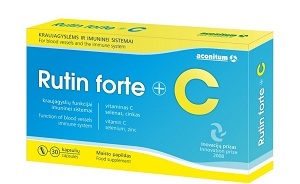 Flavonoids( plant pigments) are physiologically active elements that play an important role not only in the metabolism of plants, but also have a huge effect on the activity of enzymes. In the human body, the elements come with food.
Flavonoids( plant pigments) are physiologically active elements that play an important role not only in the metabolism of plants, but also have a huge effect on the activity of enzymes. In the human body, the elements come with food.
Today, flavonoids are widely used in folk, official medicine, as well as in cosmetology. In the official medicine, these elements are part of the medicines, dietary supplements, vitamins.
Content
- beneficial effect on the body
- properties that have substance
- Flavonoids in official medicine
- substances Varieties
- Flavonoids in nature
- Supplements based substances
- use in phlebology
- There is a point of view
beneficial effect on the body
Flavonoids have a mass of useful properties,which are taken into account in the manufacture of medical products for different areas of medicine:
- strengthens the walls of the vessels, increases their elasticity and tone;
- protection of body cells;
- prevention of aging at the cellular level;
- reduction of the effect on the body of allergens;
- preventing the development of tumors;
- protection from viral diseases;
- strengthening of immunity;
- is an effective anti-inflammatory agent;
- helps fight the unpleasant symptoms that occur in women during menopause;
- helps in the fight against cardiovascular diseases;
- are effective in diseases of the digestive tract;
- are relevant for the treatment of hepatitis.
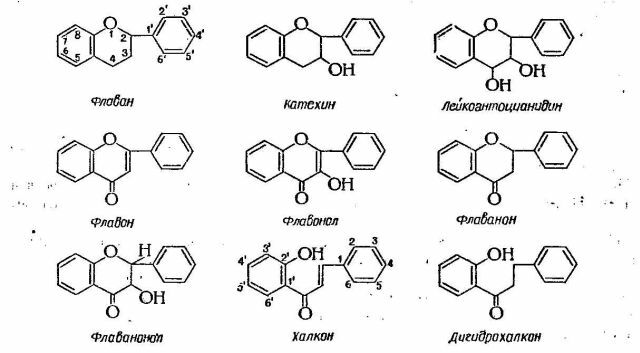
Formulas of popular flavonoids
Thus, flavonoids have a wide range of effects on the human body. They have the action:
- anti-inflammatory;
- antitumor;
- anti-radiation;
- antioxidant;
- wound-healing;
- is bactericidal;
- is estrogenic;
- is hypothetical;
- anti-tear.
Properties possessed by
substances The range of properties of flavonoids is sufficiently large, therefore, emphasis must be placed on the main ones:
- The capillary-hardening effect of is inherent in all flavonoids. Virtually all plants in parallel meet vitamins C and P and this is not spontaneous. They supplement each other, but in no case do not replace. Only in this close ligament they eliminate the fragility of the vessels, strengthen the capillaries, prevent vascular permeability not only in inflammatory processes, but also in allergies, vitamin deficiency, and capillarotoxicosis.

- The diuretic effect of is associated with the expansion of renal vessels, as well as an increase in urine filtration( primary).Thus, substances interfere with the development of urine acid diathesis, potassium deficiency, changes in the acid-base balance, development of a diabetic effect.
- The hemostatic effect of has been studied for a long time and is widely used in medical practice in the treatment of intestinal, uterine, hemorrhoidal and other bleeding of a non-significant nature.
- The mechanism cardiotropic action is associated with a positive effect on the energy metabolism of the myocardium, enriching the heart with potassium ions.
- The flavonoids of most plants possess the antispasmodic effect of .Properties are manifested in the effect on the coronary, cerebral vessels, bronchi, intestines, uterus, biliary tract. Substances relieve spasm smooth muscle.
- Sedative action of helps to stabilize blood pressure, to reduce the streptogenic effect on the vasomotor center.
Flavonoids in official medicine
Scientific studies on the ability of flavonoids to improve the elasticity of blood vessels and regulate their permeability, to fight 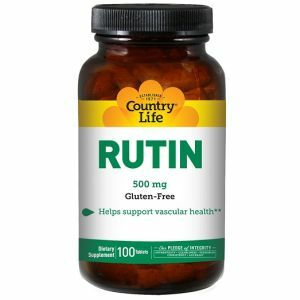 with sclerotic lesions, have long confirmed the efficacy of these substances.
with sclerotic lesions, have long confirmed the efficacy of these substances.
The most famous flavonoid is a routine that has a beneficial effect on blood vessels.
At the moment, there are more than one hundred flavonoids that have a similar action to routine.
The use of these substances is to reduce the fragility of the vessels.
High concentration of substances is in such products as peaches, apples, cocoa, tea( green), strawberries, raspberries, currants.
Popularity in medical practice has received a bilberry extract( it contains about 25% of anthocyanins), it is used in the treatment of the cardiovascular system, with varicose veins.
Varieties of substances
By general classification, flavonoids are divided into the following varieties:
- Anthocyanins are pigmented substances found in plants and cause coloration of fruits and leaves in blue, red, violet. An exception is a banana. These substances can destroy different types of bacteria, strengthen immunity, help the body to fight various infections, colds. Also anthocyanins help to strengthen the walls of blood vessels and to remove puffiness. The substances support the cell membranes in normal, preventing their damage.
- Catechins - antioxidants of natural origin, which accelerate the metabolism, increase energy consumption. The substances help to eliminate cholesterol from the body, reduce the risk of many diseases: atherosclerosis, thrombosis, stroke and heart attack. Catechins are a good prophylaxis for the development of diabetes mellitus. Thanks to the regulation of capillary permeability and the increase in the elasticity of their walls, these antioxidants are indispensable in the prevention and treatment of varicose veins and the cardiovascular system. Catechins help in removing from the body cadmium, lead, chromium and tin.
- Routine is bioflavonide, it is also a vitamin R. The substance is found in most plants and foods. It gives energy and activity to the body, slows down the aging process and improves the permeability of capillaries. Routine prevents bleeding, promotes the regeneration of tissues in various diseases( gastritis, duodenal ulcer and stomach).
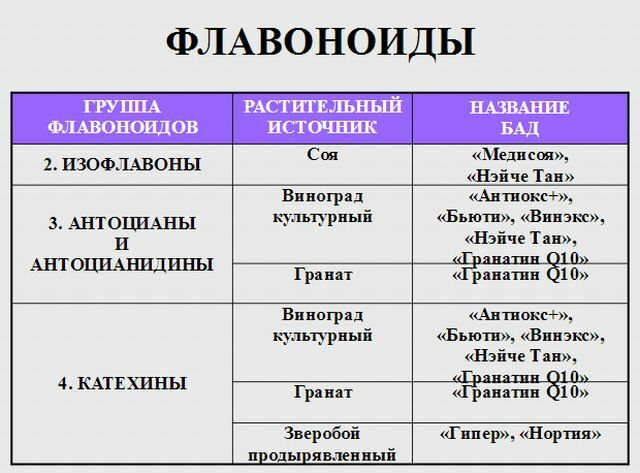
Flavonoids in nature
Flavonoids( most common in higher plants) play a huge role in plant metabolism. Some of them - pigments, give an appropriate color to the plant. So chalcones, aurons, flavones, flavonols provide orange, yellow color. 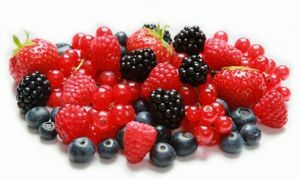 Blue, red, purple colors provide anthocyanins.
Blue, red, purple colors provide anthocyanins.
Flavonoids take part in photosynthesis, act as protective agents in pathogenesis, form suberin and lignin. Substances take a direct part in the processes of seed germination, cell death, in the process of lengthening the growing parts of plants.
Leukoanthocyanins and catechins, unlike others, do not impart color, since they are colorless and are the ancestors of tannic substances.
The best sources of flavonoids are citrus fruits, berries and fruits, green tea, dark beer, red wine sorts, black chocolate, sea-buckthorn.
What is characteristic, the cheapest option for obtaining flavonoid bioconcentrates is the use of waste products from the production of wines and juices. Such substances are most effective.
As for tea - the most powerful antioxidant is the green variety. Further on the increase in color, the taste qualities are enhanced, but the antioxidant value decreases.
BASs based on substances
In practical medicine, preparations based on flavonoids have found the widest application.
Preparations based on flavonoids are an excellent supplement to basic treatment and basic medicines. As 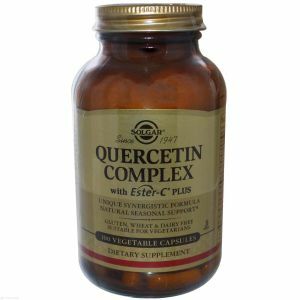 drugs are flavonoids Quercetin and Rutin( they are also P-vitamins).
drugs are flavonoids Quercetin and Rutin( they are also P-vitamins).
Their functions are most clearly manifested in combination with ascorbic acid and are used to reduce the fragility of capillaries, increase the elasticity of erythrocytes, inhibition of blood coagulability( hawthorn, motherwort).
The licorice root is used in medicine as an anti-inflammatory, antiulcer( preparations based on it, in most cases have names corresponding to the name of the plant).
Hemostatic properties are drugs based on pochechuynoy grass, water pepper. From hemorrhoids will help get rid of horse chestnut, pilger's stalk. In modern medicine, preparations have appeared on the basis of flavonoids, which help in the fight against malignant and benign tumors.
Use in phlebology
Drugs based on flavonoids are widely used in phlebology, since their effectiveness and absence of contraindications, in contrast to other medications( ointments, gels, tablets), which can complicate or exacerbate chronic diseases, have already been proven. Many drugs are contraindicated in pregnancy, although the problem with the veins at this time is very relevant.
In the treatment of venous insufficiency, flavonoids will be relevant: Rutin, Quercetin, Eriocridin, Catechin, Diosmin.
Drugs based on these substances are very popular in phlebology.
Japanese and buckwheat sophora is the richest source of routine production, which, in pure form and in derivatives, is a part of 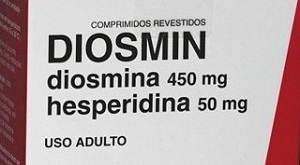 Ascorutin, Troxerutin, Venorutona, Rutozida.
Ascorutin, Troxerutin, Venorutona, Rutozida.
Endothelon is a preparation based on procionidol oligomers. The largest of them is in the grape bones( the most famous of the antioxidants).The drug increases the intracellular content of vitamin C, which, in turn, binds free radicals and reduces the permeability of capillaries and their fragility.
As preparations based on flavonoids refer to biologically active additives, their use should be started only after consultation with the attending physician, in spite of the fact that there is practically no side effect.
There is a view of
In the complex treatment of varicose, I appoint to my patients, in addition to medical procedures, a drug based on the flavonoids Detralex. The drug has proven itself and shows high efficiency. For prevention, twice a year, you can take courses of taking this drug.
Igor Shaposhnikov, phlebologist
The appointment of patients with drugs based on flavonoids makes it possible to treat varicose veins without any harm to other organs and systems( if it concerns the initial stages), and also in combination with other agents these substances are used in later stages of venousdiseases.
Valentin Kozinsky, phlebologist
